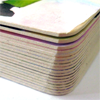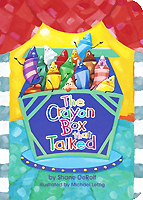|
|
|
|
|
|
|

| 최근 이 책을 구매하신 다른 회원의 책장 |
|
 |
|
|
|
[ 책 소개 ]
장난감 가게에 진열되어 있는 크레용 박스 안에는 여러가지 색깔의 크레용들이 들어 있습니다. 이 크레용들은 서로 자기가 제일 잘났다고 생각하나봅니다. 서로가 서로를 싫어하고 다른 크레용을 인정하지 않으며 언제나 남에 대해 불평불만이 가득하네요.
그러던 어느날 한 소녀가 이 크레용을 사가지고 집으로 와서 커다란 도화지 위에 그림을 그리기 시작했습니다. 파란 크레용으로는 하늘을 그리고, 노란 크레용으로는 태양을, 녹색 크레용으로는 풀밭을, 빨간 크레용으로는 꽃을, 하얀 크레용으로는 구름을 그렸습니다. 도화지에 다양한 색깔의 그림들이 점점 채워져 나가자, 그제서야 크레용들은 서로 힘을 합쳐 만든 커다란 그림이 얼마나 아름답고 멋진지를 깨닫게 되었습니다. 한 가지 색으로만 그린 그림보다, 다양한 색깔이 서로 어울리면서 민든 그림은 눈이 부시게 아름답지요...
문장은 쉽고 간결하지만 다양성과 조화로움에 관한 커다란 교훈을 깨닫게 해주는 책입니다.
튼튼한 | 닫기x |  What is 보드북? What is 보드북?
보드북(Board Book)은 표지와 속지가 모두 두꺼운 카드보드지로 만들어진 책입니다. 잘 찢어지거나 구겨지지 않기 때문에 나이가 어린 아이들을 위한 책으로 주로 만들어지며, 책 내용도 원본에 비해 축약되는 경우가 많습니다. 주로 두장을 겹쳐 단단하고 오랫동안 눌려있을 경우 페이지와 페이지가 붙을 수 있습니다.
|
[ 관련 동영상 보기 ]
 ▶
[ 서지 정보 ]
Board book: 24 pages
ISBN-10: 0385373031
ISBN-13: 978-0385373036
책 크기: 17.7 cm x 12.6 cm
[ 영문 서평 ]
Book Description
"While walking through a toy store, the day before today, I overheard a crayon box with many things to say..." Once upon a time, Shane DeRolf wrote a poem. It was a deceptively simple poem, a charming little piece that celebrates the creation of harmony through diversity. The folks at the Ad Council heard it--and liked it so much that they made it the theme for their 1997 National Anti-Discrimination Campaign for Children. Following on the heels of nearly a year's worth of televised public service announcements, Random House is phonored to publish the picture book, illustrated in every color in the crayon box by dazzling newcomer Michael Letzig and conveying the sublimely simple message that when we all work together, the results are much more interesting and colorful.
School Library Journal
In this mawkish, didactic tale (a tie-in book to the TV show The Crayon Box), quarrelsome talking crayons learn to appreciate one another when the narrator draws with them, thus showing them how each helps create a bigger picture. The message of the book, to learn to appreciate rather than dislike other people's differences, is conveyed Limburger-strong (and just as cheesy) through the unremarkable rhyming text. The illustrator uses a cartoonish, faux-childlike style and a cross-hatched layering technique to create pictures that are busy rather than vivid. The lack of borders and use of matte paper make them appear crammed into the pages. The colors (especially an overused Pepto-Bismol pink and a ruined-in-the-laundry white) are distracting. Skip this cloying book in favor of Patricia Hubbard's breezy My Crayons Talk (Holt, 1996), which gets the childlike art right and spares readers the weight of the Big Important Message.
|
|
|
|
|
|
|
|
|